![]()
![]()
![]()
Use LEFT and RIGHT arrow keys to navigate between flashcards;
Use UP and DOWN arrow keys to flip the card;
H to show hint;
A reads text to speech;
21 Cards in this Set
- Front
- Back
|
what does the synthesis of an orgnic compound involve |
several different steps |
|
|
what is the importance of organic synthesis |
-chemists are able to construct synthetic pathways to prepare a desired compound -they design a molecule and then work out how to make it from readily avilable precursors - this is the use in the pharmaceutical industry. - a series of reactions is worked out at each stage modifies the starting coumpound in a particular way. -it is vital for ech stage in the synthesis to be carried out under the right conditions |
|
|
whaat are th properities of an alkane |
-very unreactive -boiling point depends on the length of he hydrocarbon chain -only radicals are sufficiently reactive to break the high enthalpy C-C and C-H bonds |
|
|
what are the properities of an alkene |
-unsaturated double bond readily undergoes addition reactions with halogens for example they decolourise bromine water. - alkenes also undergo addition with themslves to form polymers. |
|
|
what ar the properites of an amide |
-white solids with smller amides being water soluble - they are very weak acids and even weaker bases with a solution PH of roughly 7 |
|
|
what are the properities of an amine |
-fishy smell -aliphatic amines act as bronsted-lowry bases. the lone pair on the nitroen acts as a nucleophile and attacks the delta positive carbon in halogenoalkanes and acyl chlorides -amines act as lewis bases when the N atom donates its lone pair - aromatic amides are less soluble weaker bases and stronger nucleophiles |
|
|
what are the propeities of a carbonyl |
-the C=O bond is polaised and so typical reactions of the group involve nucleophillic attack the delta positive leading to another nuclreophilic addition or a condensation reaction -aldehydes act as reductants but etones do not -carboxylic acids act as weak acids and can undergo limited hydrogen bonding increasing the relattive boiling point and solubility |
|
|
what are the properities of esters |
-esters of low relative formula mass have distinctive pleasent aromas -esters can participate in hydrogen bonding as hydrogen bond acceptors but are unable to act as hydrogen bond donaters so have limited solubility in water. - as ester molecules are unable to hydrogen bond with themselves they are more volatile than comparable compounds |
|
|
what are the properities of a hydroxyl group |
-hydrogen bonding of the OH group means that alcohols hae relatively high boiing points and good solubility in water -the C-OH bond is polarised and so the delta positive carbon undergoes attack by nucleophiles - the OH group in phenols has different properities: it is cidic and only partially miscible in water at room temperature |
|
|
what are nitros properities |
-highly explosive |
|
|
what aree the properities of a phenyl group |
-delocalised bonding in the benzene ring meansthat arenes do not readily undergo addition reactions but react most commonly by electrophilic subsitiution -phyenyl groups react with halogens if a halogen carrier catalyst e,g AlCl3 is present. -compounds containig benzene rings often have characteristically strong smells. |
|
|
What are the routes for benzene |
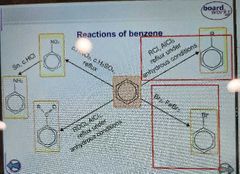
|
|
|
What are the routes for the reactions of amines |
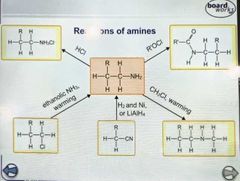
|
|
|
What are the routes for the reactions of acid chlorides |

|
|
|
What are the routes for the reactions of carboxylic acids |
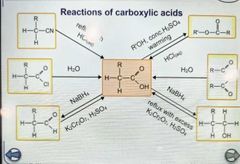
|
|
|
What are the routes for the reactions of ketones |
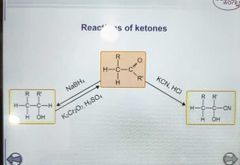
|
|
|
What are the routes for the reactions of aldehydes |
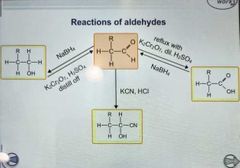
|
|
|
What are the routes for the reactions of secondary alcohols |
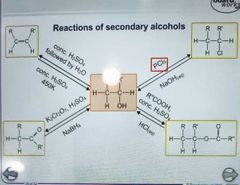
|
|
|
What are the routes for the reactions of primary alcohols |
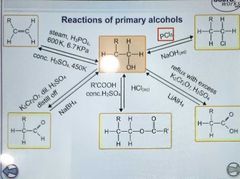
|
|
|
What are the routes for the reactions of halogenoalkanes |
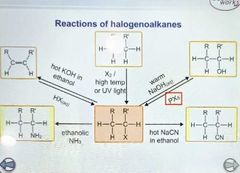
|
|
|
What are the routes for the reactions of alkenes |

|

